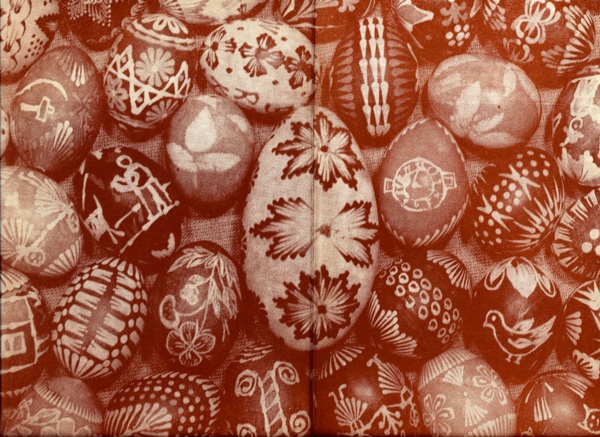
Українські Писанки Східної Словаччини
(Ukrainian Pysanky of Eastern Slovakia)
Author: Павло Маркович (Pavlo Markovych)
Edition: 1st
Format: hardcover
Pages: 188 (including plates/illustrations)
Language: Ukrainian
Illustrations: B/W, with 25 B/W and 25 color plates
Publisher: Museum of Ukrainian Culture in Svidník (Bratislava): 1972
Availability: out of print
Acquired: purchased from a collector
ISBN: N/A
This book was published, in 1972, in the Ukrainian language, by the Museum of Ukrainian Culture in Svidník (Pryashiv Division of Ukrainian Literature); it was printed by the Bratislava Slovakian Pedagogical Press. The title on the cover is simply “Pysanky.” Inside, the full title is given, “Ukrainian Pysanky of Eastern Slovakia.” This book is volume six of the museum’s educational journal, and it was later translated into English, and published in Germany in 1987 as “Rusyn Easter Eggs from Eastern Slovakia1.”
The text in the two volumes is essentially the same (albeit translated). There are chapters on
-
1.the history of the pysanka
-
2.different types of decorated eggs2
-
3.origins of pysanka ornamentation
-
4.influences of general ornamentation on pysanka ornamentation
-
5.composition of pysanka ornaments
-
6.structure of pysanka motifs
-
7.circulation of motifs
-
8.stylization of motifs
-
9.motifs in everyday life and customs
-
10. techniques in writing and ornamenting pysanky
-
11. dyeing pysanky
-
12. the symbolism of colors in folk art and folklore
-
13. games played with pysanky
The text is clearly of its time: it was written in 1972, during the height of Soviet occupation in Czechoslovakia, only a few short years after the suppression of the Prague spring. There are paeans to Soviet and Slovak rule: never in their history did the Ukrainians3 have it as good as they did in Soviet-ruled Czechoslovakia. The multi-page table of pysanka symbols and their significance (ritualistic, pastoral, etc.) includes the category “socialist,” to which only a very few symbols apparently belong: the five-pointed star, “Spartakiade,” and various combinations of the star/hammer/sickle/grain/sheaf4.


A few examples of “socialist” motifs
The Ukrainian text is well written and clear, but the same cannot always be said of the English translation. The text is sometimes awkward and the translations occasionally odd. One can understand what is being said, but reading can often be work rather than pleasure.
While the text is quite interesting, it is the illustrations that make the book. Ukrainians in eastern Slovakia decorated eggs in many ways, including two types of pysanka writing: drop-pull and linear batik. The Lemkos are the only Ukrainian ethnic group that made pysanky of the predominantly drop-pull type and, fortuitously, these are the type Markovych decided to concentrate on, although there are also photos and drawings of linear batik (pysanky written with a traditional stylus) as well as a few lystovky (Pace eggs).
Among the explanatory text and illustrations, particularly valuable is the section, with small illustrations, of typical motifs and their symbolism. Markovych delves deep into Ukrainian folk tradition and folklore to explore their meanings, and includes relevant quotations from folk songs and poetry. He does the same for the significance of color. And then there are the accompanying illustrations: two plates of different bands that can be created with drop-pull, as well as four pages of typical motifs (including the lovely Soviet ones pictured above).
As the book was published in the eastern bloc in the 1970s, the quality of the paper binding and illustrations is not the best. Several of the black and white photos within the text are barely legible, and a good number of the drop-pull pysanky are photographed in black and white. But there are hundreds of such pysanky, many in color, including several pages of water color illustrations. The colors seem genuine and traditional, and even the photos of happy Lemko women writing pysanky in their homes, although staged, do not seem horrible inauthentic.
This is a wonderful book that is, sadly, out of print. If you can find a copy, buy it, read it and enjoy it.

Endpages showing traditional Lemko pysanky and lystovky
__________
-
1.The difference in title seems to be due to the identity of the English language sponsors, one of which is the Carpatho-Rusyn Research Center. “Rusyn” is an ancient term used by Ukrainians refer to themselves; it comes from the name of the ancient Ukrainian state of “Kyivan Rus.” Some descendants of ethnographic Lemkos in the US have taken to calling them selves either “Rusyns” or “Carpatho-Rusyns” and consider themselves a separate nation. Most Lemkos in Europe (whether in Poland, Slovakia or Ukraine) consider themselves Ukrainian.
-
2.The author makes the common mistake of referring to all decorated eggs, in aggregate, as “pysanky.” It becomes clear in the text that the Ukrainian villagers being discussed have different names for different types of decorated eggs (e.g. krashanka, malyovanka, etc.), based on the technology used to create them.
-
3.«Українці» has been translated as “Rusyns” in the English-language version of the book.
-
4.Needless to say, few of these “traditional” symbols predate Soviet hegemony and those that did had entirely different meanings.
Back to MAIN Писанка Books home page.
Back to MAIN Books home page.
Back to Pysanka Bibliography.
Search my site with Google




